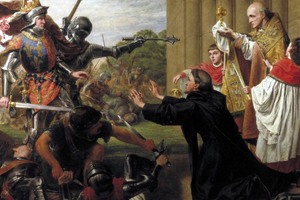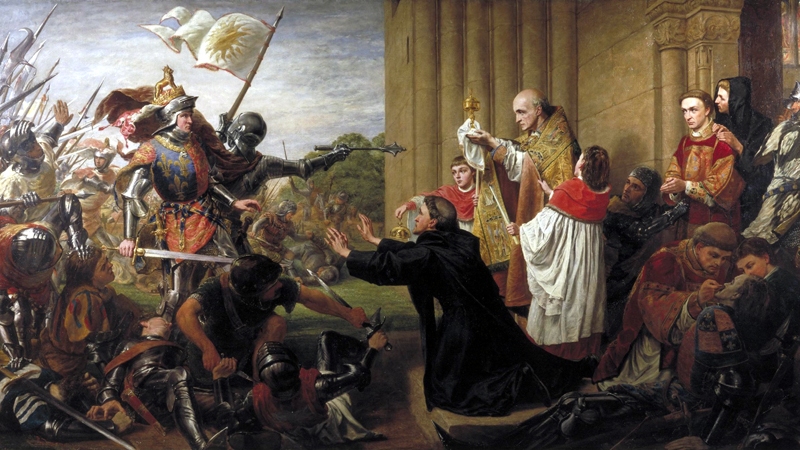
It is paradoxical that super-progressive California would have recourse to a concept of medieval law to support its revolt against federal immigration law enforcement.
It is even more bizarre that the super-secular Golden State would consider itself a kind of Church with authority higher than that of the government and declare itself a holy and sacred “sanctuary.”
But that is what is happening in California today. It has enacted legislation that effectively turns the whole state into one big sanctuary by banning local officials from asking about a person’s immigration status. Moreover, authorities in 15 counties and 35 communities have proudly declared themselves “sanctuaries.” Such declarations do great harm to the rule of law and the true idea of sanctuary.
But calling itself a sanctuary state is different from being one. California cannot be a sanctuary state, at least not in the traditional sense. Its embrace of the sanctuary concept is the upending of a good and Christian institution to serve a political agenda. The modern misuse of sanctuary could not be more contrary to its original intention.
Several things are needed for a true sanctuary. It appears necessary to review these needs that are found in English common law, the basis of American law.
A Sacred and Holy Place
The first thing needed for a sanctuary is a place outside of the common daily life. The idea of sanctuary comes from the notion that there are places that are sacred and holy within which any impurity, violence or shedding of blood would defile them. It also presupposed an authority superior to that of the state that reigns in this place and might serve as an intercessor for an offender.
What Does Saint Thomas Say About Immigration?
There are some Biblical references in the Old Testament to sanctuary-like places. However, it was only Christian civilization that fully developed the notion of a sanctuary. Christian sanctuaries were first recognized by Roman law at the end of the fourth century. The sanctuary privilege later spread throughout Europe. It was first limited to the altar area in a Catholic church but then extended to other areas of the church and its grounds.

For sanctuary to exist, there must be a notion of a separation. It cannot be a whole region or city. The place of sanctuary must be somehow consecrated to God and therefore considered sacred. It must be under a separate authority, one that lies beyond the reach of the state.
California does not fulfill any of the conditions to be a true sanctuary. It is not a small area, but the nation’s third-largest state. Its territory is not sacred in the sense of being set apart for God’s service and worship. Instead, it has turned itself into a secular state where nothing is sacred. Nor does it allow itself to be governed by a higher authority that can intercede with Washington on the sanctuary-seeker’s behalf.
Indeed, California cannot supply a place of true sanctuary. Its state, county and city governments have no legal standing in these cases.
What does Saint Thomas Aquinas say about Marriage?
The Recognition of an Alleged Criminal
The second requirement of sanctuary is the acknowledgment of criminal behavior. The notion of sanctuary was not elaborated for those who are innocent or victims of injustice, but for the guilty. Usually, the sanctuary-seeker was a fugitive from justice. Although some might be proven innocent later, most sought better terms of punishment for a crime.
This criminal recognition is absent in the current debate. Rogue “sanctuary” authorities see sanctuary-seekers as innocent of all wrongdoing. They see them as the victims of unjust federal laws. Although some may have criminal records and be a danger to society, such facts are not considered in the debate. In the case of illegal immigrants, it is an undeniable fact that all those involved have broken the law. However these California authorities refuse to accept this or act upon it.
[like url=https://www.facebook.com/ReturnToOrder.org]
Thus, California cannot be a place of true sanctuary because it seeks to absolve rather than intercede for the criminal. This attitude undermines the rule of law.
An Instrument of Justice
The third element of true sanctuary is the recognition that this medieval institution was an instrument of justice sanctioned and approved by both Church and state. It was never an escape from justice, but an option within the judicial order. Church and state worked together to make sanctuary a temporary protection, not a permanent condition. It was a manner by which the criminal sought to attenuate punishment, not avoid it altogether.

Photo: Edward IV at Tewkesbury Abbey where the king is prevented by clergy from pursuing Lancastrian fugitives into a church. “Sanctuary” painted by Richard Burchett, 1867.
How True Sanctuary Worked
English common law recognized the right of felons to take refuge in the sanctuary of any church. It thus allowed them to stay in places where they did not represent a threat to society at large.
However, sanctuary was always understood to be a reprieve. Once reaching safety, the fugitive was kept and fed until deciding to either submit to trial or confess to a serious crime. This confession might result in swearing to leave the realm and never return without the king’s permission. The banishment often deprived the offender of all property and possessions.
A person was not allowed to stay in sanctuary indefinitely. If the fugitive refused to submit to eventual justice, the authorities could starve the person into submission after forty days.
It is easy to see how California seeks to undermine the premises of true sanctuary by denying its temporary character and aiding and abetting the obstruction of justice. Ironically medieval sanctuary usually led to the outlaw’s deportation. California extends a right to remain in society.
The Perfection of Justice
Sanctuary served to perfect not subvert justice. Beyond the realm of individual punishment, the practice had social benefits that helped keep the peace. It made law less brutal by diminishing the use of capital punishment for felons. It provided a cooling off period that prevented the hasty practice of justice or punishment without trial.
Sanctuary delayed judgment, providing time for negotiating alternatives. It protected the criminals from vendettas, by removing them from the injured party’s retaliation. This diminished the possibility of family feuds that threatened the peace of the realm.
The institution of sanctuary was a court of last resort, governed by both civil and Church canon law. The fugitive was deemed to be under the protection of divine law, beyond, but not contrary to, the reach of worldly powers. It held the king’s law in suspense while clergy acted as intercessors. And while the Church tempered justice with mercy, clerical officials never denied the need for punishment for breaking the law.
Above all, sanctuary served as a means to rectify the criminal’s relationship with God. It was a penitential moment. By asking that felons confess their crimes before God and men, both the Church and the state clearly had in mind the salvation of the souls of those involved.
Because sanctuary was a check upon tyranny and unchecked government, it has always been hated by those who sought absolute power. That is why Henry VIII abolished most sanctuary provisions in England, and the French Revolution did away with them in France. Modern civil law has also eliminated it.
Turning Wisdom Upside Down
The modern sanctuary movement and its enacted laws and ordinances represent an abuse of law. It takes an institution born of the charity, justice, and wisdom of the Church and turns it upside down.
California’s “sanctuary” laws subvert justice by failing to work together with government officials to perfect the rule of law. Liberal officials there set themselves up as a higher moral authority while making a mockery of federal law. Worse yet, these same officials count on the help of Church progressives who seek to give the movement a Christian veneer and to mobilize aging activists.
Instead of keeping the peace, these laws provoke bitter divisions among the nation’s citizens. They diminish respect for authority. They fail to punish those who break the law, especially those with criminal records.
California can never be a sanctuary state because what it proposes is not true sanctuary. Fortunately, Orange County’s Los Alamitos just passed an ordinance on March 19 saying it will not obey California’s unjust sanctuary law. Hopefully, many more cities and counties will become sanctuaries from modern sanctuary laws.
[like url=https://www.facebook.com/ReturnToOrder.org]
As seen in Crisis Magazine.



